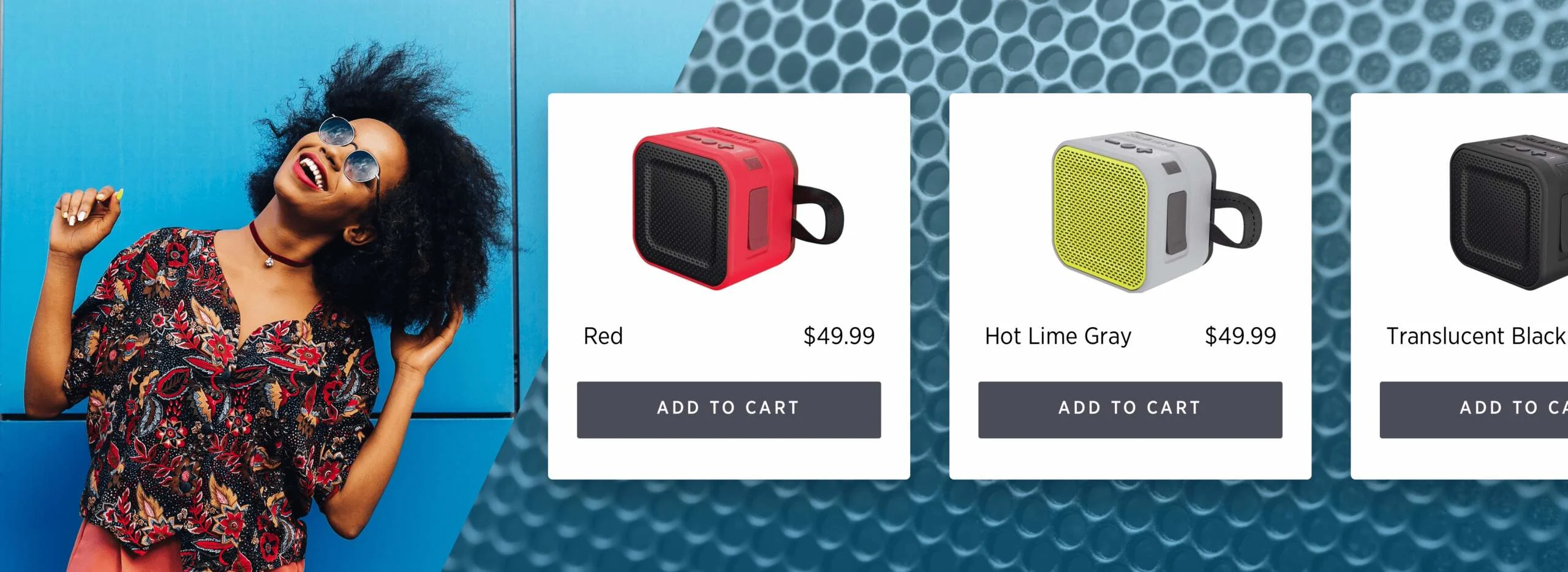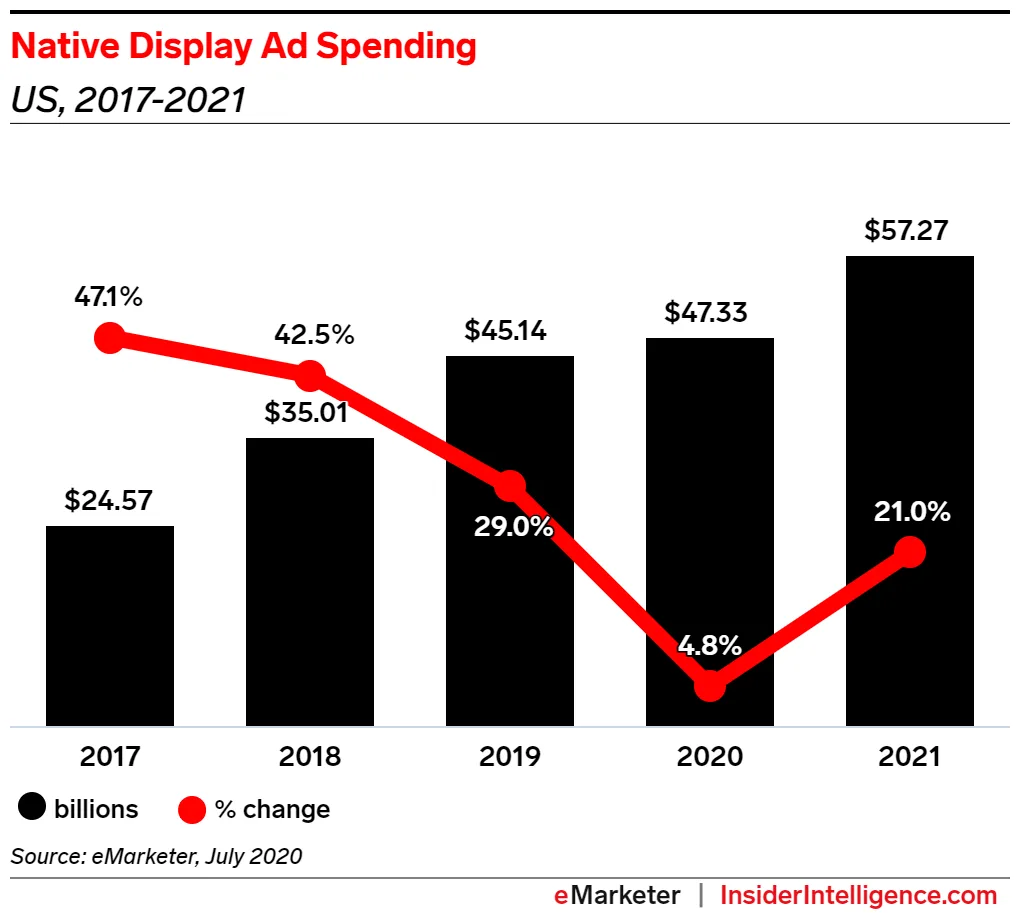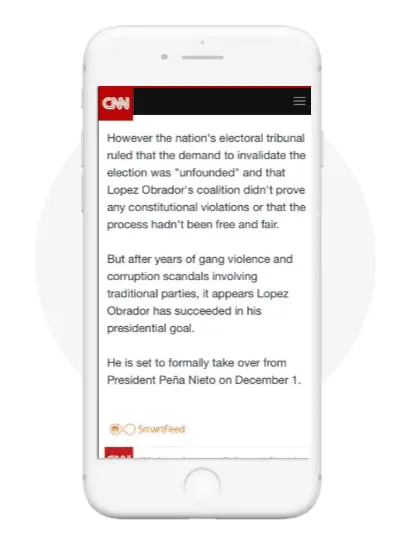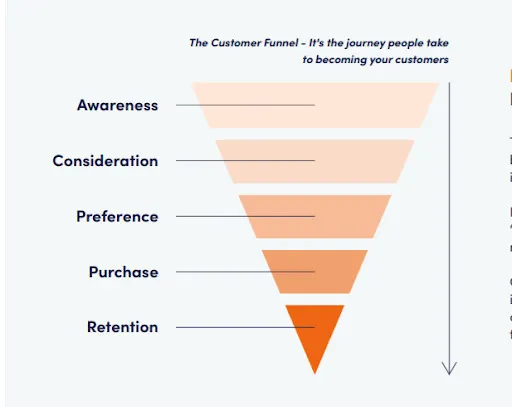Why Ecommerce Marketers Worldwide Are Turning to Native Advertising

Just about everyone working in marketing today will have heard about native advertising – and many are already using it. In 2020, native advertising spend in the US alone was over $47 billion, accounting for 63.2% of all digital advertising.
Translation? Last year, six out of every 10 digital ads were native ads.
And, of course, that’s not the only thing of note to happen in 2020.

Faced with lockdowns and social distancing, 2020 was the year of ecommerce. According to a UN global consumer study, “the COVID-19 pandemic has forever changed online shopping behaviours.”
A boom in online shopping, together with a rapid move towards native advertising, signifies something big going on in the world of ecommerce marketing. For ecommerce sellers not yet using native advertising, now is the time to learn what is native advertising, how it works, and how it can be used to boost sales as part of a diverse digital marketing strategy.
What is Native Advertising?
Have you ever scrolled down a web page and clicked on a recommended article? If so, then you have interacted with a native ad.
Native advertising is a form of paid digital advertising in which ads take on the look and feel of editorial content on a web page. Unlike banner ads or popups that stand out and often disrupt the user experience, native ads are designed to be non-intrusive, seamlessly integrating with the content and design of the web page where they appear.
1. Why native ads are different – and often better.
Consider a regular display ad. Its aim is to promote a product, service or brand and it uses the traditional sales pitch to do so. “Special offer!”, “All your sporting needs here”, or even “25% off now!”.
Native ads operate in a subtler way. The primary purpose of a native ad is not to sell; it is to provide value to the audience, to help them solve their problems or improve their lives. Native ads entertain, educate, or inform – in other words, they engage potential customers with useful, relevant content.
There’s another important distinction of a native ad: Because native ads are not focused on the hard sales pitch, they usually only reference the brand or product in a tangential way.
For example, imagine a display ad about a new lawnmower. It features an image of the mower, the brand and model name, and the discounted price in a large prominent red font. This type of ad is a dime a dozen, and every internet user sees ads like these hundreds of times a day. So many times, in fact, that they become tired of them, leading to the dreaded marketer’s curse of “banner blindness” or “ad fatigue.”
Now, imagine a native ad by the same lawnmower brand. The ad headline reads:
5 simple tips for beautifully level lawn…
…set with an image of a person mowing in the sunshine.

Example of a native mobile ad. Image courtesy of Outbrain
When the user clicks on the native ad, they land on the lawnmower company’s blog, where they read an article featuring helpful tips on how to improve their lawn. The article might even mention the new lawnmower or a beneficial feature, but that’s not the central message.
The native ad and linked content are crafted from the perspective of the customer, focusing on their needs and interests, not those of the lawnmower company! And that makes all the difference.
How Does Native Advertising Work?
There are three key players in the “dance” of native advertising:
Advertisers: Companies promoting their brand, products, services and offers. The advertiser buys space on websites where their native ads will appear.
Publishers: Websites that host native ads. There are thousands of sites that feature native ads, from high-traffic news sites like CNN to niche bloggers.
Consumers: People who browse websites and click on native ads that interest them.
And what brings these three players together? Native advertising platforms, such as Outbrain, Taboola, Revcontent and others. These platforms partner with publisher sites and provide the adtech needed to embed native ads on their web pages. Advertisers buy native ad space on publisher sites via the native platform, and they use the platform’s advanced targeting features to promote those ads to specific audiences and relevant customers.
Now let’s look at the native advertising process from the perspective of the online audience. Here’s what happens:
A person browses online, checking out their favorite news and entertainment sites. As they scroll down and read an article, they encounter a native ad.
The ad did not appear out of nowhere. It was targeted to the specific user based on their previous browsing activity.
The native ad catches the user’s attention, as it offers useful and engaging information about a topic that interests them.
The user clicks on the ad, and is taken to the host URL of the native content. In this case, let’s say it is the article mentioned earlier about “5 tips for beautifully level lawn”, hosted on the blog of a lawnmower company.
The user reads through the article. A number of things can happen. Perhaps the reader becomes aware of the brand, and bookmarks the website for later. Maybe they enjoyed reading the blog so much, they subscribe to receive email updates. And in the best case scenario, they may even click through to a product page and buy a lawnmower.
Creating a successful native campaign involves much more than just designing ads. It can only happen when marketers have a deep understanding of the target audience’s interests and pain points, and when they use it to craft content that captures the attention of relevant, high-potential customers.
How Native Advertising Has Evolved
It may seem that native is a thoroughly modern and advanced mode of advertising, but in fact the principle behind it has been around for a long time. The very first native ad is believed to be from as far back as 1885, when Buffalo Bill’s vaudeville show featured Native American leader Sitting Bull in its advertising posters. From the wild American west to today’s global internet, the idea of capturing audience attention via relevant content is what native advertising is all about.
The contemporary concept of native advertising dates back to 2011, when the term was first coined at the Online Media, Marketing and Advertising Conference. In that same year, Facebook introduced “Sponsored Stories”, paid content sponsored by companies that appeared in users’ news feeds. In the decade since, native ads have taken the form of “Promoted Stories”, “Articles You Might Like” or “Recommended for You”, appearing in native “widgets” embedded on a web page.
Today, with the help of extremely advanced adtech and audience targeting methodologies, native ads can include videos, carousel-style ‘catalogs’ with multiple images, in-app mobile ads, and in-article ads positioned in between paragraphs of an article, so the user sees the ad as part of the reading experience.

How the native feed works on the open web. Image courtesy of Outbrain
1. Personalized feeds on the open web.
With the incredible proliferation of Facebook and other social media, consumers have become accustomed to scrolling through personal news feeds that feature selected content based on their previous activity and behavior on the network.
With native advertising, companies can get featured on similarly styled “content feeds” of their target audiences on the much larger scale of the open web. Moreover, depending on the native platform, advertisers can gain access to ad space on some of the world’s premium websites, such as the leading news and entertainment organizations, sports channels, and publishers in international markets too.
A critical point to remember about native advertising is that it mimics the social media experience of the “feed”, but this time on the open web – the parts of the internet that are open to the entire global public – rather than on the closed networks of specific social platforms.
Benefits of Native Advertising for Ecommerce
According to eMarketer, the global retail ecommerce market grew in 2020 to a value of $4.28 trillion! Even without knowing the exact figure, every ecommerce business owner can tell you from experience how tough and competitive today’s marketplace truly is, and how important it is for every advertising dollar to prove its ROI.
The most important job of an ecommerce marketer is keeping consumers engaged as they move along the digital journey from potential customer to retained customer. Here is a brief outline of that journey:
Awareness: The consumer has not yet heard of the brand or product. With exposure during online browsing sessions, they become familiar with the brand and start building awareness.
Consideration: The consumer has encountered the brand or product in some way online. Now they delve deeper, exploring relevant content, learning about it, and developing a connection with it.
Preference: At this stage, the consumer demonstrates that they have developed a preference for the brand over other competitors. Perhaps they actively seek out the brand’s content online, or engage more deeply with it, visiting the website, clicking on ads, etc.
Purchase: After strengthening their connection with the brand over time, the consumer decides to convert, turning them into a customer. Conversion may involve purchasing a product or service, or some other action, such as completing a lead form or requesting a sales call.
Retention: After the customer has converted, the brand works to maintain a connection with them so they will continue to be an active customer; for example, by encouraging them to purchase again or engage with the company in other ways.

The beauty of native advertising for ecommerce is that it is incredibly flexible to fit in with all types of customers at every stage of the journey, whether through generating awareness, building trust, or convincing them to convert and purchase.
Let’s take a look at the ways that native advertising can boost ecommerce activity for a range of goals and KPIs:
1. Increased brand awareness.
Brand recognition does not happen in an instant. Native advertising is a relatively simple and cost effective way to increase brand exposure among high potential target audiences.
By purchasing native ad space on publisher sites where their target audiences visit often, or by retargeting past customers with native ads during their daily browsing, brands can significantly and effectively boost awareness when and where it matters most.
2. Credibility.
Trust is an incredibly important issue for contemporary consumers, particularly in the online space where traditional face-to-face relationships between sellers and buyers can’t exist. According to the Edelman Trust Barometer survey, 81% of consumers say they must be able to trust a brand they buy from.
With native advertising, ecommerce companies can choose which publisher sites their ads appear on, and gain access to some of the world’s leading websites, such as BBC, ESPN, Time and many more. By appearing on premium websites, ecommerce brands are assured a safe advertising environment and the credibility and trust that comes with high-quality ad placements.
3. Higher engagements.
Because native ads are “native” to the surrounding web page (or in other words, they fit seamlessly with the form and feel of the page), they don’t seem like ads. And that means that consumers interact with them differently than they would with regular ads, and mostly for the better.
According to a study that used eye-tracking technology to assess how people respond to native ads, 25% more people looked at in-feed native ads than display ads.
In addition, 32% of respondents said they would share a native ad with a family member or friend, compared with 19% for display ads. Bottom line: native ads get more engagement and deeper interaction than traditional ads.
4. Decreased time-to-purchase.
The best native advertising platforms offer extremely advanced targeting options. This means that advertisers can serve specific types of content to highly segmented audiences. When the right content is served to the right audience at the right time, it optimizes the customer journey and increases its efficacy.
For example, a popular targeting method is Lookalike Audiences. This feature analyzes an existing, high-converting audience, and builds new audience segments based on their characteristics, online interests and behavioral profiles.
Lookalike Audiences by their makeup are therefore more likely to convert than typical, generalized approaches to audience targeting, such as age range or gender. By focusing on relevant audiences, ecommerce brands can weed out low-potential customers and create faster conversions.
5. More sales.
Native advertising is the perfect storm: engaging content targeted to relevant audiences, promoted on premium websites that attract high quality traffic. Is it any wonder then that native ads are associated with 18% increased purchase intent and ecommerce marketers are increasingly leveraging native ads to increase sales?
How to Launch a Successful Native Advertising Campaign
A successful native advertising campaign is part science, and part art. It requires knowledge of the target audience, creative skills for crafting ads and content, and some adtech experience to help focus on targeting and KPIs. On the other hand, native advertising platforms today are highly user friendly, offering advanced tools for campaign design and management that are not difficult to learn. As with all digital marketing activities, success in native requires patience, experience and perseverance.
Here are the four basic steps to launching a native ad campaign toward success:
1. Choose the right native advertising platform.
There are several native advertising platforms to choose from and it’s important to make the right choice. There are several factors to consider. First, the different native platforms have partnerships with different publishers and websites, so it’s critical to choose a platform that works with publishers who get high traffic from your relevant target audiences. Some advertisers work with several native platforms at the same time to maximize their exposure and audience reach across more publisher sites.
Another factor to look out for is targeting features. Which platforms offer the best targeting options for your needs? Focus on things like Lookalike Audiences, attribute targeting, and interest targeting (targeting specific customers based on their interests and past online behavior). Also important is advanced features that can automate native advertising and optimize towards specific goals. Each native network has its own features and benefits, and there is no right or wrong choice.
2. Establish your native advertising goals.
As with any digital marketing activity, setting quantifiable and measurable goals is key. It is the only way to know whether a campaign is successful, and how to optimize it. There are several goals commonly used in native ad campaigns. Here’s a brief rundown:
Brand awareness: This can be measured with website visits, time spent on web pages, and monitoring search trends for the company name, product name or relevant keywords.
Audience engagement: This can be measured with CTR of native ads, blog visits, time spent on blogs, and more.
Lead generation: A native ad can lead to a landing page that features a lead form. The number of leads generated from the landing page indicates the success of the native campaign.
Customer acquisition: How many leads generated from native ad campaigns turn into new customers? Native ads can be very effective to kick off the nurturing flow for prospects and convert them to new customers down the road.
Conversions: For many marketers, this is the holy grail of success in native advertising. How many conversions were generated from a native ad? A conversion could be downloading an ebook, purchasing a product, signing up for a newsletter, installing an app, or any other action.
Once the goal of the campaign is set, it is time to start creating the assets: the native ad and the linked content.
3. Develop the unique content.
Native advertising is a great way to promote all kinds of content for all kinds of customers. Examples of the types of content that work well with native include: blogs, ebooks, white papers, infographics, videos, podcasts, testimonials, reviews, stories, app downloads, product pages, and interactive content, such as quizzes and polls.
A new consumer in the awareness stage can get to know a brand better via a quirky testimonial video promoted natively. Or a customer who converted in the past can be retargeted with a native ad about a new product feature that might interest them. The ad can link to a blog about the new feature. There are so many types of content that can be used to engage customers with native – the only limit is the imagination.
4. Focus on reporting.
This is when the goals and KPIs you decided in step two come back into play. After launching a native campaign, it is vital to monitor and track the results so it can be optimized to achieve better results. Many native advertising platforms provide tools and features in the dashboard to assist in campaign optimization and support A/B testing of native ads.
For example, an advertiser can choose to run two versions of a native ad featuring different images or headlines. The ad that comes closer to reaching the KPI metric is clearly the better performer, and the campaign can be optimized in the future to feature the high performance version.
Remember, targeting on native ad platforms is based on algorithms that learn over time what ads work best for which customers and audiences. With smart optimization tactics, advertisers can leverage these algorithms to boost their native results.
Native Advertising – The Cure for Ecommerce Marketers
When native advertising hit the scene in 2011, there was no way of knowing that in the next decade, it would explode to overtake traditional display as one of the most popular and effective forms of paid advertising. Year on year, native advertising spend worldwide grows at a fast pace.
Particularly today, as social media networks struggle with issues surrounding free speech and data privacy, native advertising is proving to be a powerful and reliable alternative to get reach and exposure among the enormous global audience of the open web. For ecommerce marketers, whose number one goal is to maximize conversions in overcrowded marketplaces, the potential and need for native advertising is becoming clearer and more urgent every day.

Laura has over 12 years of experience writing for Israeli and multinational companies operating all over the world. As Outbrain's content writer for growth, she devotes her time to digging deep into every aspect of performance marketing, while raising three kids, a cat, and running her own writing business.


